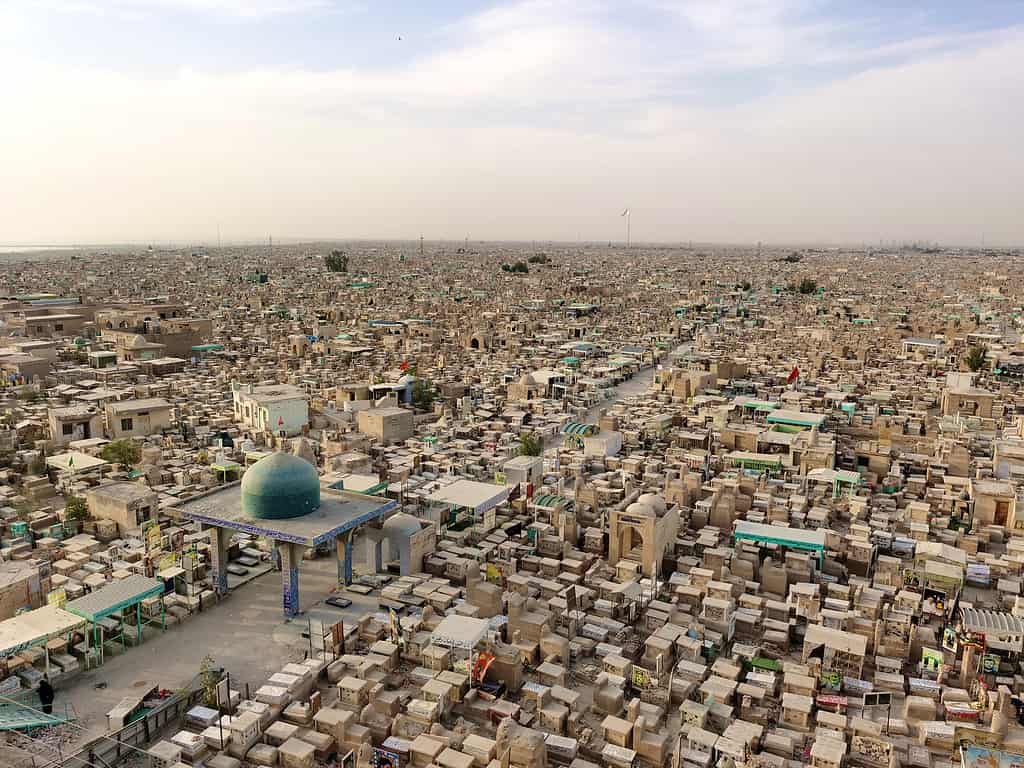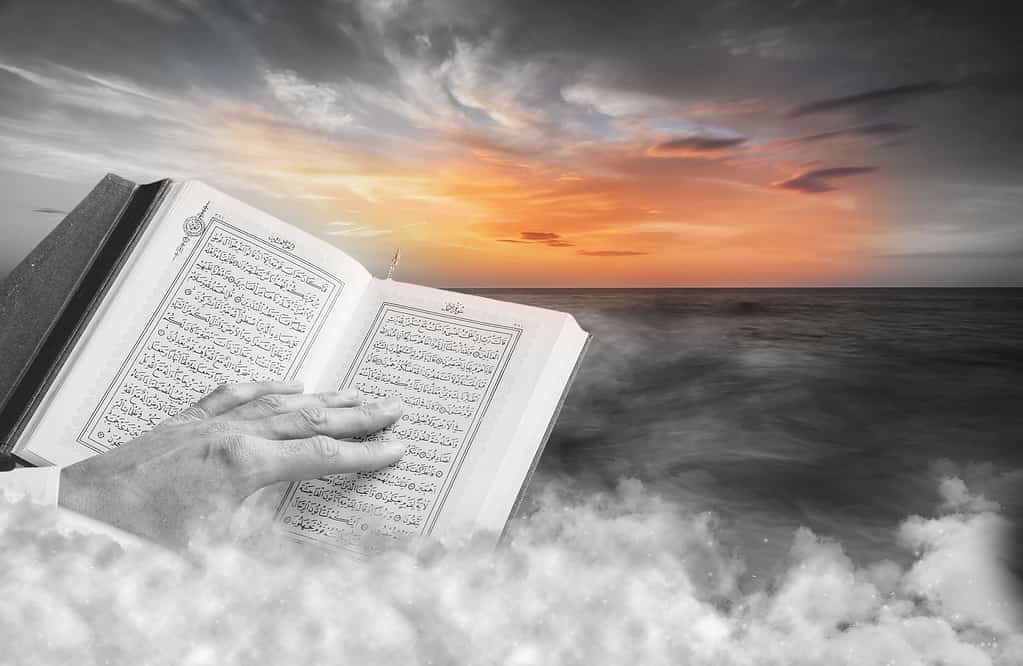Since the dawn of human consciousness, reverence has been shown to the dead members of many societies. As a result, many burial places exist as archaeological sites or active cemeteries. What active cemetery has the most people buried in it? We’ll discover the largest cemetery in the world with over 6 million graves!
What is the Largest Cemetery In the World?

Wadi al-Salam in Najaf, Iraq, is the largest cemetery in the world with over 6 million interments.
©Ziquan Ying/iStock via Getty Images
The largest cemetery in the world is the Wadi al-Salam in Najaf, Iraq. There are over 6 million people interred at this site with continual burials taking place for over the last 1400 years. Because of this rich history, Wadi al-Salam may become a UNESCO World Heritage Site as it’s on the tentative list.
When the Iraq War in the first decade of the twenty-first century was at its peak, up to 250 people were buried at Wadi al-Salam daily. During the 2017 conflict with ISIS, up to 350 people were buried every day. Today, less than 100 people are interred per day.
Wadi al-Salam means Valley of Peace in English, and this cemetery takes up about 13 percent of the total area of the City of Najaf. It occupies about 2.34 square miles of land. Tombstones are crowded around mausoleums, and there are vaults and catacombs underneath the cemetery.
Most of the graves are constructed with brick and plaster, and their sizes are not homogenized. Some of the crypts onsite store up to 50 dead, and almost all of the dead at Wadi al-Salam identified in life as Islamic.
Wadi Al-Salam: What Famous People Are Buried at the Largest Cemetery in the World?
Many famous Islamic people are buried at Wadi al-Salam though being famous is not a necessity. In actuality, poor people are buried among the rich all over the cemetery without much segregation between classes. There are important scientists, prophets, clerics, politicians, sultans, kings, princes, and others interred at this cemetery.
Some of the Ancient Burials at Wadi al-Salam

The Prophet Hud mentioned in the Qur’an is buried at Wadi al-Salam.
©Mahmoud Saleh/iStock via Getty Images
Hud is an ancient prophet mentioned in the Qur’an and is buried in Wadi al-Salam. Hud was a prophet among the Ad people, a rich society that worshipped Allah and self-created idols.
The Prophet Hud tried to get them to worship Allah alone since idol worship is wrong in Islam, but he was mocked and rejected. As a result, Allah sent a storm that obliterated Ad.
The next prophet, Saleh, was sent to the Thamud tribe and witnessed their destruction after trying to preach for the same reasons that Ad was destroyed. He is also buried at Wadi al-Salam.
Some of the Modern Burials at Wadi al-Salam
Amina Haydar al-Sadr is buried at Wadi al-Salam along with her brother Muhammad Baqir al-Sadr. Amina was an activist, women’s rights advocate, and educator. Her brother was a philosopher, and together they had formed a movement opposing Saddam Hussein.
They were both captured in 1980 and tortured. Amina al-Sadr was hung, and her brother had a nail hammered through his head before being burned to death.
Mohammad Sadeq al-Sadr made sure that both Amina and Baqir were buried at Wadi al-Salam. Mohammad Sadeq al-Sadr was later interred in a mausoleum at the cemetery upon his death.
Sadeq and two of his sons were shot and killed in Najaf in 1999. This happened because he and his family also bucked against Saddam Hussein which resulted in their deaths. Knowing he was going to be killed soon, Mohammed Sadeq al-Sadr wore a death shroud when giving his last sermon to show that the Shi’ites would overcome intimidation.
Wadi Al-Salam: The Largest Cemetery Is a Religious Site

All of the dead will be raised on Judgement Day at Wadi al-Salam according to Shi’ites.
©Ziquan Ying/iStock via Getty Images
Wadi al-Salam is a religious site with cultural importance to Muslims. It’s important as an Islamic interment site because it’s near the Imam Ali Mosque. Many believe that being buried at this cemetery means they will be among those raised from the dead on Judgement Day.
There is also lore suggesting that Abraham from ancient times had purchased land that is now a part of Wadi al-Salam. There are also rumors that the Prophet Adam, the first man from Paradise, is also interred at the cemetery along with Noah. However, the validity of Abraham’s land purchase and the burials of these ancient prophets is contested.
Shi’ite Muslims who live in Iraq and surrounding Muslim countries like Iran see this location as a top-tier burial ground. As a result, most Shi’ites in Iran and Iraq have at least one relative buried at Wadi al-Salam.
The local government is trying to buy more land to expand the cemetery as it’s overcrowded. This overcrowding has led to illegal burials and vandalism of grave sites as people try to secure interment for their loved ones without official permission.
Where in Iraq is Najaf?

Najaf is approximately one hundred miles south of Baghdad in Iraq.
©dk_photos/iStock via Getty Images
Najaf is about one hundred miles south of Iraq’s capital Baghdad in the middle of the country. About 750 thousand people call Najaf home. This means that the living are far outnumbered by the dead residents of the city.
It is often called Najaf al-Ashraf which means Dignified Najaf because of the religious importance of the city. Najaf was founded in 791 CE in honor of Ali ibn Abi Talib who, according to Shi’ite Muslims, was Mohammed’s first successor. He was also the son-in-law and the cousin of the Prophet Mohammed. The city grew around the tomb erected in Ali ibn Abi Talib’s memory.
Archaeological evidence shows that in ancient history, Najaf had the largest Christian cemetery in the region as well. It was a little smaller than 2 and a quarter miles in size. Proof of civilization dating back to 100 BCE also exists, and pottery with crosses and Hebrew lettering from as early as 600 CE shows that multiple religions coexisted in the same area historically.
Other Things to Do in Najaf, Iraq

The Tomb of Imam Ali at the Imam Ali Mosque is a major Shi’ite pilgrimage site.
©Robert Victor/iStock via Getty Images
The United States has a Level 4 travel advisory established for Iraq which means that citizens of the United States are urged to not travel to the region under any circumstances. However, that doesn’t mean that there aren’t sights to see in Najaf that may be accessible someday via tourism. Also, other cities with different cultures than the United States provide millions of religious visitors to the country every year.
Today, Najaf, Iraq, is a Muslim holy city. It is revered as important because it is the location of the Imam Ali Mosque which holds Ali ibn Abi Talib’s tomb. This makes the Imam Ali Mosque hugely important as a pilgrimage site, and it is the top tourist destination in Najaf. It is also the third most important site for pilgrimage in all of Islam.
The house that Imam Ali Ibn Abi Taleb lived in is available for tour. While it has been renovated many times, it still shows the simplicity of the era in which the Imam lived. Most pilgrims who make the trek to Najaf try and visit this site.
Another important religious site in the area is the Great Mosque of Kufa. It has survived since the seventh century though it’s been rebuilt many times. Despite this, it’s still one of the oldest mosques in the world.
The Great Mosque of Kufa is actually in the City of Kufa along the Euphrates River. It is attached to Najaf and is considered part of Najaf’s metropolitan area. Shi’ites believe that Noah built the Ark here, and it is also the site where Ali ibn Abi Talib was fatally wounded.
The photo featured at the top of this post is © Ziquan Ying/iStock via Getty Images
Thank you for reading! Have some feedback for us? Contact the AZ Animals editorial team.







